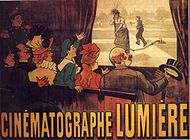Lumiere Brothers & the Cinematographe
 The Lumière brothers were born in Besançon, France, in 1862 and 1864, and moved to Lyon in 1870, where both attended La Martiniere, the largest technical school in Lyon. Their father, Claude-Antoine Lumière (1840–1911), ran a photographic firm and both brothers worked for him: Louis as a physicist and Auguste as a manager. Louis had made some improvements to the still-photograph process, the most notable being the dry-plate process, which was a major step towards moving images.
The Lumière brothers were born in Besançon, France, in 1862 and 1864, and moved to Lyon in 1870, where both attended La Martiniere, the largest technical school in Lyon. Their father, Claude-Antoine Lumière (1840–1911), ran a photographic firm and both brothers worked for him: Louis as a physicist and Auguste as a manager. Louis had made some improvements to the still-photograph process, the most notable being the dry-plate process, which was a major step towards moving images.
It was not until their father retired in 1892 that the brothers began to create moving pictures. They patented a number of significant processes leading up to their film camera, most notably film perforations (originally implemented by Emile Reynaud) as a means of advancing the film through the camera and projector. The original cinématographe had been patented by Léon Guillaume Bouly on 12 February 1892. The brothers patented their own version on 13 February 1895. The first footage ever to be recorded using it was recorded on March 19, 1895. This first film shows workers leaving the Lumière factory.
The Lumières held their first private screening of projected motion pictures in 1895. Their first public screening of films at which admission was charged was held on December 28, 1895, at Salon Indien du Grand Café in Paris. This history-making presentation featured ten short films, including their first film,Sortie des Usines Lumière à Lyon (Workers Leaving the Lumière Factory). Each film is 17 meters long, which, when hand cranked through a projector, runs approximately 50 seconds.
It is believed their first film was actually recorded that same year (1895) with Léon Bouly's cinématographedevice, which was patented the previous year. The cinématographe — a three-in-one device that could record, develop, and project motion pictures — was further developed by the Lumières.
On February 13, 1895, the Lumiere brothers patented their Cinematographe, which was a combination of the camera and projector. The Cinematographe was hand-cranked, lighter, and smaller than the Kinetoscope, and played film at a slower speed, 16 frames per second, while the Kinetoscope played at 48 frames per second, but created a lot of noise and used more film. Another benefit of the Cinematographe was that it played actual films, while the Kinetoscope played photographs in rapid succession. One of the first films the Lumiere brothers made shows workers leaving their factory. Click "Oldest Surviving Footage" to see this film as well as others by the Lumiere brothers. The first public showing of the Cinematographe was on December 28, 1895, and in 1896, Cinematographe theaters were built in Belgium, London, New York and Brussels. The Lumiere brothers also created the Autochrome plate in 1907, which was the first color photography process. At first, Auguste and Louis had doubted the success of their invention. As Louis Lumiere once said, "The cinema is an invention without a future." This statement has become one of irony, as cinema is now a huge success worldwide.

- Own Lumiere Brothers inspired film - "Girl Eating Sandwich" - http://www.youtube.com/watch?v=2lzN1hGEiSM
- First Lumiere Brothers film - "The Factory" - http://www.youtube.com/watch?v=VDnppCDhI9U
- "Baby's Lunch" - http://www.youtube.com/watch?v=OgGCAskh98E
- "Arrival of Train" - http://www.youtube.com/watch?v=1dgLEDdFddk
- "Waterer Watered" - http://www.youtube.com/watch?v=yOZPgx0_E54




No comments:
Post a Comment